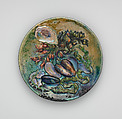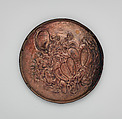Plaque with mussel and oyster shells and seaweed
Possibly Tiffany Glass and Decorating Company American
Possibly Tiffany Studios
Possibly designed by Alice Gouvy American
Not on view
This enamel plaque of oyster and mussel shells and seaweed exemplifies the lure of the ‘cult of nature’ that captivated Louis Comfort Tiffany and other decorative artists and designer both here and abroad at the turn of the century. A highly naturalistic depiction of a seemingly haphazard arrangement of a shells and marine plant life, it displays a single oyster shell at the top with seaweed in varying shades of brown, a ribbon of kelp surrounding several mussel shells, showing both the rich black shell surface and the pearly iridescence of the nacre on the inside. The surface exhibits a nearly unlimited color range and rich saturated hues. Rather than turning to more exotic sea creatures, Tiffany’s designers embraced the common sea life that might have been found locally on the beaches of Long Island Sound, where Tiffany’s country estate, Laurelton Hall, was located.
Tiffany’s exploration of enamels, which began in the late 1890s, was a logical extension of his interest in glass. The enamel shop was a special division within Tiffany’s studios, and the enamel artists were all women, headed by Alice Gouvy and Lillian Palmié. Tiffany exhibited his enamels publicly for the first time in London in 1898 and made a significant showing of them at the Exposition Universelle in Paris in 1900.
Due to rights restrictions, this image cannot be enlarged, viewed at full screen, or downloaded.
This artwork is meant to be viewed from right to left. Scroll left to view more.



